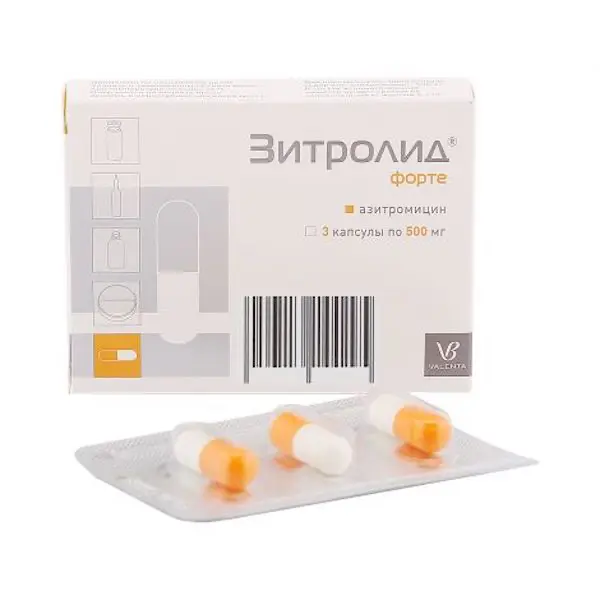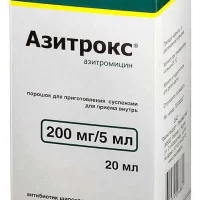Description
Zithrolide Forte Pharmacodynamics
Azithromycin is a bacteriostatic broad-spectrum antibiotic of the macrolide-azalide group. It has a broad spectrum of antimicrobial action. Azithromycin mechanism of action is associated with inhibition of microbial cell protein synthesis. Binding to 50S-subunit of ribosome, it inhibits peptide translocase at the translation stage and inhibits protein synthesis, slowing down the growth and reproduction of bacteria. At high concentrations it has a bactericidal effect.
It has activity against a number of gram-positive, gram-negative, anaerobes, intracellular and other microorganisms.
Microorganisms may be initially resistant to the action of the antibiotic or may become resistant to it.
Sensitivity scale of microorganisms to azithromycin (Minimum inhibitory concentration (MIC), mg/L):
Microorganisms MIC, mg/L
Sensitive Resistant
Staphylococcus ?1 >2
Streptococcus A, B, C, G ?0.25 >0.5
S. pneumonia ?0.25 >0.5
H. influenzae ?0.12 >4
M. caiarrhalis ?0.5 >0.5
N. gonorrhoeae ?0.25 >0.5
Sensitive microorganisms in most cases:
1. Gram-positive aerobes
Staphylococcus aureus Methicillin-sensitive
Streptococcus pneumoniae Penicillin-sensitive
Streptococcus pyogenes
2. Gram-negative aerobes
Haemophilus influenza
Haemophilus parainjluenzae
Legionella pneumophila
Moraxella caiarrhalis
Pasteurella muliocida
Neisseria gonorrhoeae
Anaerobes
Clostridium perfringens
Fusobacterium spp.
Prevotella spp.
Porphyriomonasspp.
4. Other microorganisms
Chlamydia trachomatis
Chlamydia pneumonia
Chlamydia psittaci
Mycoplasma pneumonia
Mycoplasma hominis
Borrelia burgdorferi
Microorganisms that can develop resistance to azithromycin:
Gram-positive aerobes
Streptococcus pneumoniae Penicillin-resistant
Initially resistant microorganisms:
Gram-positive aerobes.
Enterococcus faecalis
Staphylococci (methicillin-resistant staphylococci show a very high degree of resistance to macrolides)
Gram-positive bacteria that are resistant to erythromycin.
Anaerobes
Bacteroides fragilis
Indications
Infectious-inflammatory diseases caused by microorganisms sensitive to azithromycin:
– Upper respiratory tract and ENT-organ infections: pharyngitis, tonsillitis, sinusitis, otitis media;
– lower respiratory tract infections: pneumonia (including atypical, exacerbation of chronic pneumonia), bronchitis (including acute, exacerbation of chronic);
– skin and soft tissue infections: common acne (moderate severity), rye, impetigo, secondary infected dermatoses;
– Infections of the urinary tract: gonorrheal and non-gonorrheal urethritis, cervicitis;
– initial stage of Lyme disease (borreliosis) – erythema migrans.
Contraindications
– Hypersensitivity to azithromycin (including other macrolides), components of the drug;
– Severe renal insufficiency (creatinine clearance (CK) less than 40 ml/min);
– severe hepatic insufficiency (grade B or higher on the Child-Pugh scale);
– lactation period;
– children under 12 years of age and body weight less than 45 kg;
– concomitant use with ergotamine and dihydroergotamine.
With caution:
Pregnancy, arrhythmias, including predisposition to develop arrhythmias and Q-T interval prolongation (risk of ventricular arrhythmias and Q-T interval prolongation), renal failure (CK greater than 40 ml/min), hepatic failure (below grade B, Child-Pugh scale), myasthenia gravis, concurrent administration with terfenadine, warfarin, digoxin.
Pregnancy and lactation:
Azithromycin penetrates the placenta. Administration during pregnancy is possible only in case if the expected benefit for a mother exceeds the potential risk for a fetus. If it is necessary to use azithromycin during lactation period breast-feeding should be stopped.
Dosage and administration method
- Orally, 1 hour before or 2 hours after a meal, once a day.
- Adults and children over 12 years of age with body mass over 45 kg:
– In infections of upper and lower respiratory tract, ENT organs, skin and soft tissues – 500 mg per day in 1 dose for 3 days (course dose – 1.5 g).
– Common acne – 500 mg per day at a single dose for 3 days, then 500 mg per day once a week for 9 weeks. The first weekly dose should be taken 7 days after the first daily dose (day 8 from the start of treatment), the next 8 weekly doses of g at 7-day intervals.
– In acute urinary tract infections (uncomplicated urethritis or cervicitis) – once 1 g.
– In case of the disease. Lyme disease – for treatment of stage I (erythema migrans) – 1 g on the first day and 500 mg daily from days 2 to 5 (course dose – 3 g).
– in treatment of pneumonia, 500 mg daily for 7-10 days; administration starts immediately after the end of intravenous dosage form (the recommended dose when administered intravenously is 500 mg once daily for at least 2 days).





